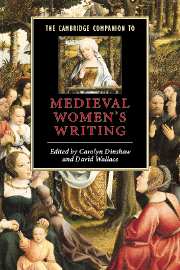1 - Female childhoods
from Part I - Estates of women
Published online by Cambridge University Press: 28 May 2006
Summary
Medieval persons showed nuanced awareness of human lifespan development. The familiar 'ages of man' texts generally followed one of three conceptual systems: the biologists' theory of three ages (youth, maturity, and old age); the physiologists' theory of four ages (childhood, youth, maturity, and old age), corresponding to the four humours, seasons, and elements; and the astrologers' theory of seven ages (infancy, childhood, adolescence, youth, maturity, old age, decrepitude) following the Ptolemaic structure of the universe. By the later Middle Ages a stable set of terms divided childhood into seven-year segments: infantia (infancy), pueritia (childhood), and adolescentia (adolescence). These demarcations were based primarily upon age but also considered the social, emotional, and mental development of the individual. Prior to the age of seven or infantia, an infant girl was not considered to be a fully rational and responsible agent. The transition to pueritia was marked by growing personal awareness and social accountability, and the move into adolescentia was marked by the onset of menarche and secondary sexual characteristics. At adolescentia, regarded as twelve for girls and fourteen for boys, young people could marry according to canon law or could break a marriage contract arranged in their childhood by paying a fine equivalent to the value of the marriage. Although remaining unmarried was a possibility, the life options available to most girls were limited to marriage, religious vocation, or some form of domestic employment or household management. The social ideal, of course, was for young medieval girls to marry and have children, for the normative course of secular life led a girl directly from her father’s house as a child and daughter to her husband’s house as a wife and mother.
- Type
- Chapter
- Information
- The Cambridge Companion to Medieval Women's Writing , pp. 13 - 20Publisher: Cambridge University PressPrint publication year: 2003
- 3
- Cited by



